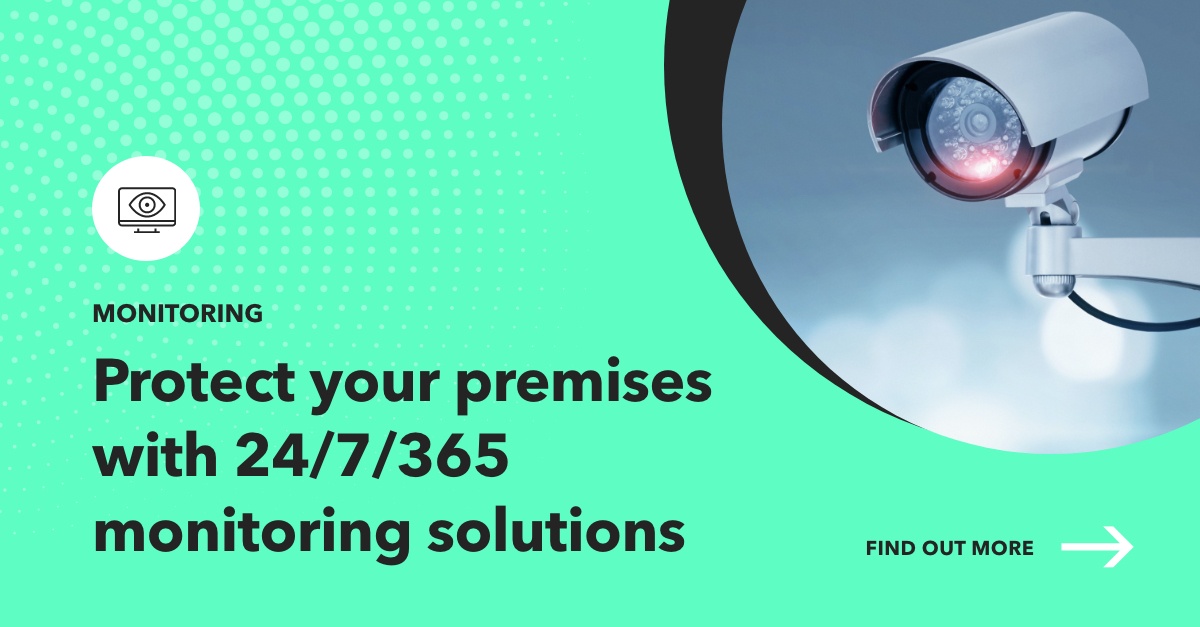Installing CCTV cameras in the workplace is vital for keeping a company’s people, buildings and assets safe. They can help deter potential criminals, monitor the activity of workers and visitors, and in the unfortunate event of a crime occurring, help collect evidence to find out exactly what happened.
Knowing just where to position CCTV cameras in the workplace requires some consideration. However, there are some key places that may be vital to cover to ensure the business gets the most out of its CCTV system.
Here, we outline some of the best positions for CCTV cameras in the workplace.
Entrances & Exits
CCTV cameras should be positioned at all entrances and exits to the premises. This will give your client full visibility of who is coming and going at all times.
Positioning the cameras above the door and pointing away from light sources and windows will ensure they pick up a clear view of people’s faces.
The cameras placed at entrances to the building should be fully visible. This will help to deter potential intruders as it makes them aware they are under observation. A bullet camera is usually the best choice because they are instantly recognisable.
Car parks
Car parks can be a target for theft and vandalism. Installing CCTV cameras here can help deter criminals but also identify them if an offence does take place.
PTZ (Pan Tilt Zoom) cameras are often a good choice for car parks because they offer a high degree of surveillance from a single point and can zoom in and focus on car number plates in real-time. Multiple sensor cameras are also a good choice because they can capture up to 360-degree fields of view and are effective in low light conditions.
Reception
The reception area of a building typically has lots of people coming and going and it could be one of the most likely areas intruders will attempt to enter.
CCTV cameras installed in the reception will allow your client to keep an eye on everyone using the area and pick out unrecognised visitors or anyone acting suspiciously.
In the office area
Of course, you want to avoid people feeling like they are being watched at all times. However, if there is a requirement to monitor the office area, it is a good idea to opt for a corner location so it captures the majority of the workspace without violating the privacy of individuals.
Storerooms
Storerooms holding sensitive documents are a potential target for theft and vandalism. CCTV cameras positioned at the entrance and exits of a storeroom will allow your client to keep track of who is accessing the space, including any unauthorised personnel.
Server rooms
Server rooms are critical to the business, and any theft or vandalism that occurs here could have significant consequences. CCTV cameras will help spot if any unauthorised personnel attempt to enter the space.
Due to server rooms often being very dark, cameras with 2D or 3D digital noise reduction or infrared light should be used in order to capture the best picture quality.
Warehouses
Warehouses storing thousands of pounds worth of inventory can be a prime target for theft and other criminal activity. CCTV cameras should be placed at entrances and exits to the warehouse as well as within the building.
Cameras positioned outside should be clearly visible to ward off intruders. Inside the warehouse, turret cameras are particularly useful in areas with very low light conditions.
Customer interaction points
CCTV cameras should always be installed in areas where there is customer interaction, especially if monetary transactions take place. It is important not to mount cameras too high so you can capture people’s faces and not the top of their heads.
Getting the height right
The height of the camera needs to be carefully considered. If placed too low it could be at risk of vandalism, but if placed too high or too far away it could hinder the quality of the images which could disrupt the identification of faces.
It is quite common for cameras in the workplace to be placed at 2.5m or 5m. Placing cameras at 2.5m gives a close-range view, providing higher quality images for identification. To get a view of a wider area, it is better to place cameras at 5m.
Getting the right angle
Cameras are typically installed at a vantage point with the camera angled downwards. This allows them to focus on objects whilst also capturing the surrounding area.
The size of the camera lens will also influence how the camera should be angled. Cameras with a smaller lens size will increase the viewing angle but reduce the depth of field.
Your security partner will be able to give personalised advice on where to position the cameras, including the height and angle, in order to provide the best level of security for the premises.
For enhanced protection, you may also consider adding a remote monitoring service alongside the CCTV system. Today’s CCTV cameras are great for identifying intruders or anyone carrying out unauthorised or harmful activities, but by this point, the damage has already been done. Implementing a remote monitoring service means that staff can be alerted of any suspicious activity in real-time.
To learn more about where to position CCTV cameras in the workplace, and the types of cameras that are most suitable for different areas, our specialist team of security experts will be happy to help.





 Previous Blog
Previous Blog

Comments.